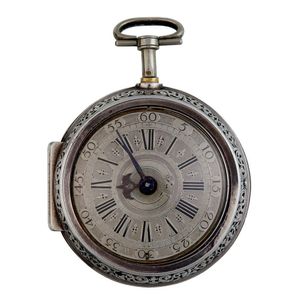Late 17th Century Quarter Striking Pair Cased Watch
You must be a subscriber, and be logged in to view price and dealer details.
Subscribe Now to view actual auction price for this item
When you subscribe, you have the option of setting the currency in which to display prices to $Au, $US, $NZ or Stg.
- Quarter Striking - A clock that srtikes on the quarter hour, as well as on the hour.
- Pair Cased - A pair cased watch is one with a double case. The movement is encased, and for additional protection this is fitted into an outer case.
- Fusee - The fusee movement was used in clocks and pocket watches from the mid 17th century. The fusee is a cone shaped drum within the works that is linked to the barrel of the spring, usually by a length of chain.
As the mainspring loses its tension over time, the cone shaped barrel compensates for this by increasing the tension, by pulling the mainspring tighter, thus ensuring the time remains constant.
Use of the fusee in clocks was superseded by the "going barrel" in the mid 19th century and for pocket watches at the beginning of the 19th century.
The fusee continued to be used in marine chronometers until the 1970s. - Barrel (in a Clock) - In a clock or watch, the barrel is a cylindrical component that stores the energy from the mainspring. As the mainspring is wound, it stores energy in the barrel. As the clock or watch runs, the energy is gradually released from the barrel, turning the clock's gears and keeping the time.
The barrel is typically located near the centre of the movement (the mechanism that powers the clock) and is connected to the center wheel, which drives the rest of the gears. The barrel typically has teeth on its outer surface that mesh with the gears in the movement, allowing it to transmit energy to the rest of the clock. Some barrels are designed to be wound by hand, while others are automatically wound by the motion of the wearer's arm. - Movement - The technical name for the workings of a clock or watch, and does not include the dial or case.
- Circa - A Latin term meaning 'about', often used in the antique trade to give an approximate date for the piece, usually considered to be five years on either side of the circa year. Thus, circa 1900 means the piece was made about 1900, probably between 1895 and 1905. The expression is sometimes abbreviated to c.1900.
This item has been included into following indexes:
-
pocket watches, case type
- pair cased 165
- silver case 905
- silver, open face 204
Visually similar items

A large silver plated cased chronograph pocket watch, key wind movement, white enamel dial with Roman numerals, repairs to enamel

A lady's gold open face pocket watch J M Wendt, Adelaide crown wind, pin set, gold dial. Base metal curvette. 14ct gold engraved case. Weight 38.7 grams.

Waltham 9ct gold lady's pocket watch; open face with white dial, Roman numerals, subsidiary seconds dial on a 15 jewel movement, C 1912. Case marked Birmingham 1915. Wt. 32.9g

A French quarter repeater fusee verge pocket watch, Curvet and movement and signed Breguet and Files, circular 18ct gold fancy engraved dial with Roman numerals, with engraved hunting scene depicting stag and hound, 18ct gold case, diameter 50 mm, circa 18
